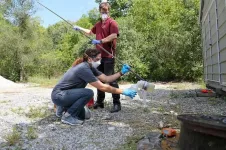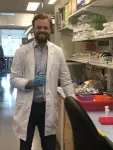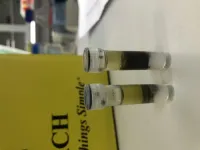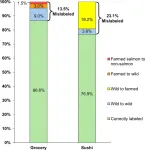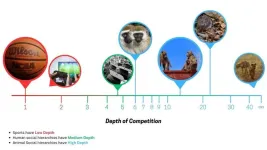(Press-News.org) Waterborne diseases affect over 7 million people in the U.S. every year, according to the Centers for Disease Control and Prevention, and cost our health care system over $3 billion. But they don’t impact all people equally.
A campuswide collaboration is using sewage surveillance as a vital strategy in the fight against diseases that spread through the water such as legionella and shigella. The ones that are most difficult to combat are diseases with antimicrobial resistance, which means they are able to survive against antibiotics that are intended to kill them.
A recent paper in Nature Water offers an encouraging insight: Monitoring sewage for antimicrobial resistance indicators is proving to be more efficient and more comprehensive than testing individuals. This approach not only detects antimicrobial resistance more effectively but also reveals its connection to socioeconomic factors, which are often key drivers of the spread of resistance.
The paper’s corresponding author is Peter Vikesland, the Pryor Professor of Engineering in the civil and environmental engineering department. The full list of authors at Virginia Tech, in addition to Vikesland, are:
Suraj Gupta, computer science
Xiaowei Wu, statistics
Liqing Zhang, computer science
Amy Pruden, civil and environmental engineering
The team is collaborating across Virginia Tech with experts such as Leigh-Anne Krometis in biological systems engineering and Alasdair Cohen and Julia Gohlke in population health sciences to focus on serving rural communities where the issues are most acute.
The significance
Globally, low-to middle-income communities bear the brunt of infectious diseases and the challenges of antimicrobial resistance. Sewage surveillance could be a game changer in addressing these disparities. This method not only captures a snapshot of antimicrobial resistance at the community level, but also reveals how socioeconomic factors drive the issue.
The study
The National Science Foundation Research Traineeship focuses on advancing sewage surveillance to combat antimicrobial resistance. The work is integral to broader efforts led by Vikesland and the Fralin Life Sciences Institute program for technology enabled environmental surveillance and control to sense and monitor waterborne health threats.
The study analyzed data from 275 human fecal samples across 23 countries and 234 urban sewage samples from 62 countries to investigate antibiotic resistance gene levels. Socio-economic data, including health and governance indicators from World Bank databases, were incorporated to explore links between antibiotic resistance genes and socio-economic factors. The group utilized machine learning to assess antibiotic resistance gene abundance in relation to socio-economic factors, revealing significant correlations. Statistical methods supported the finding that within country antibiotic resistance gene variation was lower than between countries.
Big picture, the team's findings show sewage surveillance is emerging as a powerful tool in the fight against antimicrobial resistance. It even has the potential to protect vulnerable communities more effectively.
END
Sewage surveillance proves powerful in combating antimicrobial resistance
Research from an interdisciplinary team at Virginia Tech shows public health promise
2024-11-06
ELSE PRESS RELEASES FROM THIS DATE:
Natural environment is declining: are companies doing their part to save it?
2024-11-06
The natural environment across the globe is deteriorating, leading to crises like climate change, biodiversity loss, and water scarcity. Companies and industries play a major role in this decline, and they are expected to take responsibility for their environmental impact. A recent study by Probal Dutta from the University of Vaasa, Finland, suggests that companies can meet these expectations by openly sharing reliable, credible information about their activities, environmental performance, and effects on nature.
Probal Dutta’s doctoral dissertation at the University ...
New study sheds light on the role of sound and music in gendered toy marketing
2024-11-06
A groundbreaking study from Queen Mary University of London reveals that the music and soundscapes used in toy commercials are reinforcing rigid gender norms, shaping the way children perceive masculinity and femininity. The research uncovers how gender stereotypes are not only conveyed through visuals and language but are also deeply embedded in the sound and music used in advertisements targeted at children.
For more than 40 years, research has shown how gender polarisation in children’s ...
Pathogens which cling to microplastics may survive wastewater treatment
2024-11-06
Wastewater treatment fails to kill several human pathogens when they hide out on microplastics in the water, reports a new study led by Ingun Lund Witsø of the Norwegian University of Life Sciences, published November 6, 2024 in the open-access journal PLOS ONE.
Wastewater treatment plants are designed to remove contaminants from wastewater, but microplastics persist and can become colonized by a sticky microbial biofilm. Previous research has suggested that these microbial communities, called plastispheres, include potential pathogens, and thus might pose a risk to human health and the environment when treated wastewater and sludge are released.
In the new study, researchers ...
Effects of preterm birth extend into adulthood, study finds
2024-11-06
By analyzing all live births in Canada over a six-year period and following children for more than two decades, researchers found that preterm births and the related cognitive, development and physical health impacts of prematurity are associated with lower income, employment and university enrollment
Individuals born before 37 weeks of gestation, considered to be preterm infants, have, on average, lower employment income, university enrollment and educational attainment through age 28, according to ...
Salmon frequently mislabeled in Seattle grocery stores and sushi restaurants
2024-11-06
In a study of salmon samples from Seattle, Washington, grocery stores and sushi restaurants, DNA analysis revealed that 18 percent were mislabeled. Tracie Delgado and colleagues at Seattle Pacific University, WA, U.S., present these findings in the open-access journal PLOS ONE on November 6, 2024.
Washington State is one of the top suppliers of wild salmon eaten in the United States. The price of salmon depends on the species and whether it is farmed or wild caught. Prior studies have revealed frequent mislabeling of salmon in Washington markets and restaurants. In 2013, the state made it illegal to mislabel salmon, citing negative ...
15,800-year-old engraved plaquettes from modern-day Germany depict fishing techniques, including the use of nets, not previously known in the Upper Paleolithic
2024-11-06
15,800-year-old engraved plaquettes from modern-day Germany depict fishing techniques, including the use of nets, not previously known in the Upper Paleolithic
###
Article URL: https://journals.plos.org/plosone/article?id=10.1371/journal.pone.0311302
Article Title: Upper Palaeolithic fishing techniques: Insights from the engraved plaquettes of the Magdalenian site of Gönnersdorf, Germany
Author Countries: Germany, U.K.
Funding: Deutsche Forschungsgemeinschaft DFG (Germany) - AHRC (UK) Memorandum of Understanding Grant DFG-Projekt GZ: GA 683/13-1 (AOBJ: 647648); AHRC (UK) AH/V002899/1) Kunst und Haushalt im Paläolithikum: ...
How plants evolved multiple ways to override genetic instructions
2024-11-06
Biologists at Washington University in St. Louis have discovered the origin of a curious duplication that gives plants multiple ways to override instructions that are coded into their DNA. This research could help scientists exploit a plant’s existing systems to favor traits that make it more resilient to environmental changes, like heat or drought stress.
The study led by Xuehua Zhong, a professor of biology in Arts & Sciences, was published Nov. 6 in Science Advances.
Zhong’s new research focuses on DNA methylation, a normal biological process in living cells wherein small chemical groups called methyl ...
Nasal swab tests predict COVID-19 disease severity, Emory study finds
2024-11-06
A wide variety of COVID-19 symptoms exist, ranging from mild to severe, and while current strains of the virus generally cause milder symptoms, those with co-morbidities are still at an exponentially greater risk of severe disease. Now, new research from Emory University is providing a more precise prediction of COVID-19 severity that can be found by looking at autoantibodies in the nasal cavity, leading to more personalized treatment plans. For high-risk individuals, this could provide critical information to inform immediate treatment options, including ...
'Shallow' sports and 'deep' social hierarchies: Not all pecking orders are created equal
2024-11-06
University of Michigan researchers have added a new dimension to the mathematics used to predict the outcomes of all manner of competitions, including sports, games and social hierarchies in both humans and animals.
This dimension, which they call "depth of competition," can be integrated into a variety of important and lucrative fields. It could, for instance, help project winners of match-ups in sports, forecast consumer preferences, rank universities and evaluate hiring practices.
But it also ...
New PFAs testing method created at UMass Amherst
2024-11-06
AMHERST, Mass. — University of Massachusetts Amherst researchers have discovered a new way to detect per- and polyfluoroalkyl substances (PFAS) in water. This marks an important step forward in creating testing devices that are simpler, more cost-effective, faster and generally more accessible than existing methods.
PFAS, the so-called forever chemicals, have been recognized as a concerning pollutant.
These chemicals persist in the environment because they resist breaking down and pose significant health threats. Exposure to these chemicals is linked to various cancers ...
LAST 30 PRESS RELEASES:
Artificial saliva containing sugarcane protein helps protect the teeth of patients with head and neck cancer
Understanding the role of linear ubiquitination in T-tubule biogenesis
Researchers identify urban atmosphere as primary reservoir of microplastics
World’s oldest arrow poison – 60,000-year-old traces reveal early advanced hunting techniques
Bristol scientists discover early sponges were soft
New study uncovers how rice viruses manipulate plant defenses to protect insect vectors
NSF–DOE Vera C. Rubin Observatory spots record-breaking asteroid in pre-survey observations
Ribosomal engineering creates “super-probiotic” bacteria
This self-powered eye tracker harnesses energy from blinking and is as comfortable as everyday glasses
Adverse prenatal exposures linked to higher rates of mental health issues, brain changes in adolescents
Restoring mitochondria shows promise for treating chronic nerve pain
Nature study identifies a molecular switch that controls transitions between single-celled and multicellular forms
USU chemists' CRISPR discovery could lead to single diagnostic test for COVID, flu, RSV
Early hominins from Morocco reveal an African lineage near the root of Homo sapiens
Small chimps, big risks: What chimps show us about our own behavior
We finally know how the most common types of planets are created
Thirty-year risk of cardiovascular disease among healthy women according to clinical thresholds of lipoprotein(a)
Yoga for opioid withdrawal and autonomic regulation
Gene therapy ‘switch’ may offer non-addictive pain relief
Study shows your genes determine how fast your DNA mutates with age
Common brain parasite can infect your immune cells. Here's why that's probably OK
International experts connect infections and aging through cellular senescence
An AI–DFT integrated framework accelerates materials discovery and design
Twist to reshape, shift to transform: Bilayer structure enables multifunctional imaging
CUNY Graduate Center and its academic partners awarded more than $1M by Google.org to advance statewide AI education through the Empire AI consortium
Mount Sinai Health system receives $8.5 million NIH grant renewal to advance research on long-term outcomes in children with congenital heart disease
Researchers develop treatment for advanced prostate cancer that could eliminate severe side effects
Keck Medicine of USC names Christian Pass chief financial officer
Inflatable fabric robotic arm picks apples
MD Anderson and SOPHiA GENETICS announce strategic collaboration to accelerate AI-driven precision oncology
[Press-News.org] Sewage surveillance proves powerful in combating antimicrobial resistanceResearch from an interdisciplinary team at Virginia Tech shows public health promise
